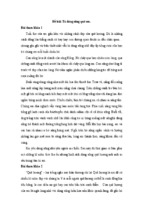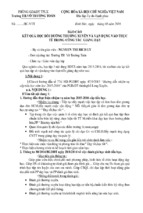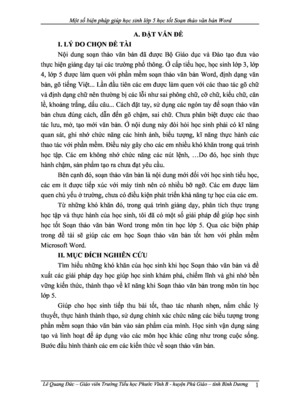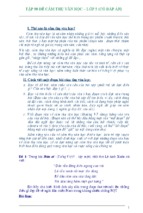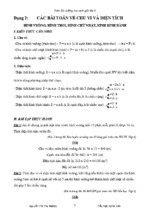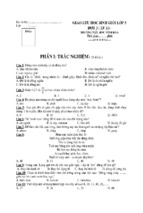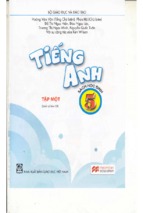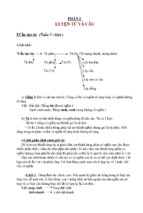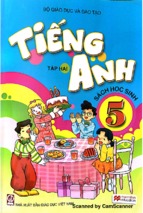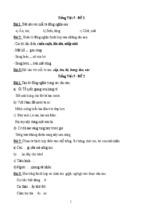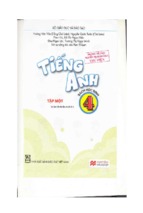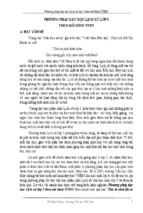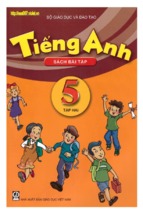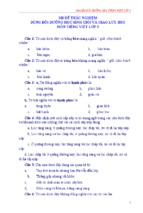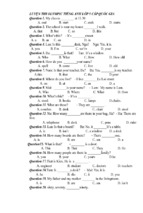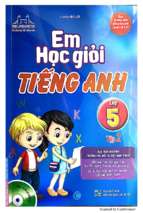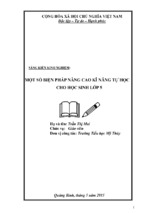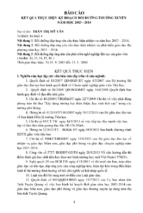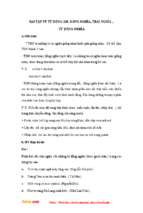Sách giáo viên tiếng anh 5 theo chương trình thí điểm phần 2
Bộ giáo dục và đào tạo
Hoàng Văn Vân (Tổng Chủ biên), Phan Hà (Chủ biên)
Đỗ Thị Ngọc Hiền, Đào Ngọc Lộc,
Trương Thị Ngọc Minh, Nguyễn Quốc Tuấn
Với sự cộng tác của Ken Wilson
Nhà xuất bản giáo dục Việt Nam
Unit 7
How do you learn English?
1 Look, listen and repeat.
How often do you
have English, Mai?
a
Do you have English today?
I have it four times a week.
2
I read English comic books.
Point and say.
How do you practise
_____________________?
I ____________.
a
Yes, I do.
How do you learn vocabulary?
How do you practise reading?
c
b
d
I write new words in my
notebook and read them aloud.
b
listen to English/
speak English/
speak English every day watch English cartoons
on TV
c
d
write English/
read English/
write emails to my friends read short stories
46
Tập 1
Tiếng Anh 5 – tập
Objectives
By the end of this unit, pupils can
• use the words and phrases related to the topic How do you learn English?
• ask and answer questions about how someone learns English, using How do you practise ...? I ...
• ask and answer questions about the importance of learning English, using Why do you learn
English? Because I want to ...
• say questions and answers with the correct sentence stress.
Warm-up: Have the class talk about their timetables from Unit 6, Lesson 3, Activity 6. Get pupils to
point at the timetables and say what classes they have. Introduce the new lesson by writing the title
How do you learn English? on the board and have the class repeat it once or twice.
1. Look, listen and repeat.
• H
� ave the class look at the pictures. Introduce the story by pointing at each character and
elicit their answers to these questions: Who are they? What are they talking about? How often
does Mai have English? Does she have English today? How does she practise reading? (In Picture
a, Tom asks Mai how often she has English and she says she has it four times a week. In Picture
b, Mai says she has English today. In Picture c, Tom asks How do you practise reading? and
Mai answers I read English comic books. In Picture d, Tom continues to ask How do you learn
vocabulary? and Mai answers I write new words in my notebook and read them aloud.)
• �Play the recording all the way through for the class to listen and follow in their books. Play it
again for them to repeat line by line.
• �Check their understanding of the story.
2. Point and say.
• Tell the class that they are going to practise asking and answering questions about how
someone learns English, using How do you practise ...? I ...
• Have pupils look at the pictures and read aloud the phrases under each picture.
• Remind them of the use of practise reading/speaking/listening/writing.
• Point at each picture and introduce the question How do you practise ...? for pupils to practise
saying the complete question, using the information under each picture. Then point at each
picture, asking the question for the class to answer.
• Have pupils practise asking and answering the questions in pairs. Then invite one or two pairs
to speak to check what they have done.
Unit 7 How do you learn English?
46T
3 Let’s talk.
Ask and answer questions about how you learn English.
How often do you have English?
Do you have English today?
How do you practise ____________?
I have English ____________ times a week.
Yes, I do.
No, I don’t.
I ____________.
4 Listen and tick.
1
2
a
b
c
a
3
b
c
b
c
4
a
b
c
a
5 Read and complete.
hobby
singing
writes
because
speaks
Trung is a newcomer in Class 5B. Today, he’s happy (1) ___________ he has
two English lessons. To practise speaking English, he (2) ___________ it every
day with his friends. To learn vocabulary, he (3) ___________ new words and
reads them aloud. He also learns English by (4) ___________ English songs.
His (5) ___________ is singing English songs!
6
Let’s sing.
How do you learn English?
How do you learn English?
How do you practise speaking?
I speak to my friends every day.
How do you practise reading?
I read English comic books.
How do you practise writing?
I write emails to my friends.
And how do you practise listening?
I watch English cartoons on TV.
47
Tiếng Anh 5 – tập 1
Unit 7 How do you learn English?
47
3. Let’s talk.
• Tell the class that they are going to practise further by asking and answering questions about
how someone learns English.
• Get pupils to work in pairs to ask and answer the questions in their books.
• Set a time limit for them to practise. Monitor the activity and offer help, if necessary.
• Invite a few pairs to act out their conversations in front of the class. Then give feedback.
Warm-up: Spend a few minutes revising the previous lesson by inviting one or two pairs to ask and
answer questions about how they learn English, using How do you practise ...? I ...
4. Listen and tick.
• Tell the class that they are going to listen to the recording and tick the correct pictures.
• Ask them to look at the pictures to identify the characters and what they do to practise
English.
• Play the recording all the way through for pupils to listen and tick the pictures. Play it again
for them to complete the task. Monitor the activity and offer help, if necessary.
• Get them to compare their answers before checking as a class. Play the recording again to
confirm the answers.
Key:
1b
2c
3a
4b
Audio script
1. Linda: How do you practise listening, Nam? 2. Linda:
Mai:
Nam: I watch English cartoons on TV.
3. Linda: How do you practise reading, Trung? 4. Linda:
Trung: I read English comic books.
Quan:
How do you learn English, Mai?
I sing English songs.
How do you learn vocabulary,
Quan?
I write new words in my
notebook and read them aloud.
5. Read and complete.
• Tell the class that they are going to read the text and fill the gaps with hobby, singing, writes,
because and speaks.
• Give them a few seconds to read the text and the words in the box. Remind them to focus on
the context to select the appropriate words. Give the meaning of newcomer.
• Set a time limit for them to do the task independently. Monitor the activity and offer help,
if necessary.
• Get them to compare their answers in pairs before checking as a class. If there is enough time,
have the class read the completed text aloud.
Key: 1 because 2 speaks 3 writes 4 singing 5 hobby
6. Let’s sing.
• Tell the class that they are going to sing How do you learn English? Have them read each line
of the lyrics. Check comprehension.
• Play the recording all the way through for pupils to listen and follow in their books. Play it
again and ask pupils to do choral repetition line by line.
• When pupils are familiar with the melody, ask the class to sing along with the music before
having them practise singing and doing actions in groups.
• Invite a group to sing the song and do actions in front of the class.
Unit 7 How do you learn English?
47T
1 Look, listen and repeat.
I have French.
What foreign language do you have at school?
English. What about you, Akiko?
a
And do you like English?
c
Oh, really?
b
Why do you learn English?
Yes. It’s my favourite subject.
d
Because I want to sing English songs.
2 Point and say.
Because I want
to ____________.
Why do you learn English?
a
b
watch English
cartoons on TV
c
read English
comic books
talk with my
foreign friends
3 Let’s talk.
Ask and answer questions about how and why you learn English.
How do you learn English?
I ____________.
48
48
Tiếng
Tiếng Anh
Anh 55 –– tập
Tập 11
Why do you learn English?
Because I want to ____________.
Warm-up: Spend a few minutes revising the previous lesson by having the class sing How do you
learn English?
1. Look, listen and repeat.
• Tell the class that they are going to read a story. Have them look at the pictures and guess
what the story is about. Check their comprehension by pointing at each picture and eliciting
their answers to these questions: Who are they? What are they talking about? What foreign
language does Hoa study at school? Does she like English? Why does she learn English? (Akiko
and Hoa are talking in the library. In Pictures a and b, Hoa says she has English at school and
Akiko says she has French. In Picture c, Hoa says English is her favourite subject. In Picture d,
Akiko asks Why do you learn English? and Hoa answers Because I want to sing English songs.)
• Play the recording all the way through for pupils to listen and follow in their books. Play it
again for them to repeat line by line chorally.
2. Point and say.
• Tell the class that they are going to practise asking and answering questions about the
importance of learning English, using Why do you learn English? Because I want to ...
• Point at each picture and ask the class Why do you learn English? for them to answer, using the
prompts under each picture.
• Ask pupils to work in pairs: one asks the question and the other answers it.
• Invite one or two pairs to perform the activity.
3. Let’s talk.
• Tell the class that they are going to practise talking about how and why they learn English,
using How do you learn English? and Why do you learn English?
• Get pupils to work in pairs. Remind them to use the questions in their books.
• Set a time limit for them to practise. Monitor the activity and offer help, if necessary.
• Invite a few pairs to ask and answer questions about how and why they learn English in front
of the class. Then give feedback.
Unit 7 How do you learn English?
48T
4 Listen and number.
practise,
listen,
speak
a
b
c
d
5 Write about you.
1. How do you practise speaking English? ____________________________________
2. How do you practise reading English? ______________________________________
3. How do you practise writing English? ______________________________________
4. How do you learn English vocabulary? _____________________________________
5. Why do you learn English? __________________________________________________
6 Let’s play.
49
How do I learn English?
(Charades)
Tiếng Anh 5 – tập 1
Unit 7 How do you learn English?
49
Warm-up: Spend a few minutes revising the previous lesson by having a few pairs of pupils ask and
answer questions about the importance of learning English, using Why do you learn English? Because
I want to ...
4. Listen and number.
• Tell the class that they are going to listen and number the pictures.
• Ask them to look at the pictures and identify the characters and their activities.
• Play the recording all the way through for them to listen and number the pictures. Play it
again for them to check their answers.
• Get them to compare their answers before checking as a class.
• Play the recording a third time to confirm the answers.
Key: a 2
b 4
c 1
d3
Audio script
1. Tony: You speak English very well!
Hoa: Thank you, Tony.
Tony: How do you practise speaking?
Hoa: I speak English with my foreign
friends every day.
3. Tony:
Mai:
Tony:
Mai:
Tony:
Mai:
How do you practise listening?
By watching English cartoons
on TV.
Do you understand this cartoon?
Yes, I do.
That’s great! Well done.
Thank you.
2. Tony:
Nam:
Tony:
Nam:
How do you learn English
vocabulary?
I write new words and read
them aloud.
Why do you learn English?
Because I want to sing English
songs.
4. Tony:
Quan:
Tony:
Quan:
How do you practise reading?
I often read English comic books.
Why do you learn English?
Because I want to read English
comic books.
5. Write about you.
• Tell the class that they are going to write answers to the questions about how they practise
English and why they learn it.
• Have them read the questions and check their understanding.
• Set a time limit for pupils to do the writing independently. Monitor the activity and offer help,
if necessary.
• Get pupils to swap and read their writing before inviting one or two pupils to read their
answers aloud.
Key: Answers vary
6. Let’s play.
• Tell the class that they are going to play How do I learn English? Remind them how to play
Charades, a guessing game using movements and facial expressions to indicate words. Call
on one or two pupils to demonstrate the game. Make sure pupils understand how to play it.
• Divide the class into two teams. Show the first team a word. One pupil of this team must act
it out. If the second team guesses the word correctly, they get a point. Then let the second
team act out a word while the first team guesses. Put all the words used in the game on the
board.
• Set a time limit for pupils to play the game. The team with more points at the end of the game
wins.
• Have the class make sentences with the words on the board.
Unit 7 How do you learn English?
49T
1 Listen and repeat.
'How do you 'practise 'speaking?
I 'speak 'English 'every 'day.
'How do you 'practise 'reading?
I 'read 'English 'comic 'books.
'How do you 'practise 'writing?
I 'write 'emails to my 'friends.
'Why do you 'learn 'English?
Be'cause I 'want to 'sing 'English 'songs.
2 Listen and circle a or b. Then say the sentences
aloud.
1. I learn English by _______________.
a. speaking it every day
b. talking with my friends
2. Mai learns English by ______________.
a. reading comic books
b. singing English songs
3. Nam learns English by ____________.
a. writing emails to his friends
b. watching cartoons on TV
4. We learn English because we want to ____________.
a. read comic books
3 Let’s chant.
b. talk with our foreign friends
How do you learn English?
How do you practise speaking?
By speaking English every day.
How do you practise reading?
By reading comic books.
How do you practise listening?
By watching English cartoons on TV.
How do you practise writing?
By writing emails to my friends.
Why do you learn English?
Because I want to sing English songs.
50
Tiếng Anh 5 – Tập
tập 1
Warm-up: Spend a few minutes revising the previous lesson by inviting some pupils to read their
answers to Lesson 2, Activity 5 aloud.
1. Listen and repeat.
• Tell the class that they are going to practise saying the sentences, paying attention to
sentence stress.
• Play the recording all the way through for pupils to listen first. Play the recording again for
them to repeat the sentences twice.
2. Listen and circle a or b. Then say the sentences aloud.
• Tell the class that they are going to listen to the recording and circle a or b to complete the
sentences.
• Give them a few seconds to read the sentences in silence.
• Play the recording for pupils to listen and do the task. Then play it again for them to check
the answers.
• Get them to compare their answers in pairs before checking as a class.
• Ask the class to read the completed sentences aloud.
Key: 1 b 2 a 3 a 4 b
Audio script
1. I learn English by talking with my friends.
2. Mai learns English by reading comic books.
3. Nam learns English by writing emails to his friends.
4. We learn English because we want to talk with our foreign friends.
3. Let’s chant.
• Tell the class that they are going to say the chant How do you learn English? Have pupils read
the chant and check their comprehension.
• Play the recording all the way through for pupils to listen and follow in their books. Play it
again for them to repeat it line by line.
• Put the class into two groups to practise chanting once or twice.
• Have pupils practise saying the chant and doing actions in groups.
• Invite two groups to the front of the class to say the chant and do actions. The rest of the class
claps their hands along to the rhythm.
Unit 7 How do you learn English?
50T
4 Read and tick True (T) or False (F).
My name is Mai. I love reading English comic books. When
I see a new word, I try to guess its meaning. I write the
word in my notebook and say it a few times. I often stick
new words on my bedroom walls and practise reading them
aloud. I learn to speak English by talking with my foreign
friends in my free time. My friend Akiko is good at English.
She usually practises listening by watching cartoons on TV.
She learns to write by writing emails to me every day. We
are happy because we can understand each other. English is
necessary for communication.
practise
comic
ons
o
cart
study
story
h
lis
Eng
1. Mai tries to guess the meaning of a word while she reads.
2. Mai often learns to speak English by herself.
3. Akiko usually practises listening by watching cartoons on TV.
4. Akiko learns to write English by writing emails to Mai every day.
5. They like learning English because it is necessary for their studies.
song
T
5 Write about how your friend learns English.
My friend is _________________________________________________________________.
He/She learns to read English by ___________________________________________.
He/She learns vocabulary by ________________________________________________.
He/She learns English because ______________________________________________.
6 Project
Discuss how you practise listening, speaking, reading and writing English.
7 Colour the stars.
Now I can ...
t ask and answer questions about how and why someone
learns English.
t listen to and understand texts about how and why someone
learns English.
t read and understand texts about how and why someone
learns English.
t write about how your friend learns English.
51
Tiếng Anh 5 – tập 1
Unit 7 How do you learn English?
51
F
Warm-up: Spend a few minutes having the class say the chant How do you learn English? and do
actions.
4. Read and tick True (T) or False (F).
• Tell the class that they are going to read the text about how and why Mai and Akiko learn
English, and tick T or F.
• Give them a few seconds to look at the picture and ask: Who’s this? What’s she doing? How does
she learn English?
• Explain the meaning of understand each other.
• Set a time limit for pupils to do the task independently. Monitor the activity and offer help,
if necessary.
• Have pupils compare their answers before checking as a class.
Key: 1 T 2 F 3 T 4 T 5 F
5. Write about how your friend learns English.
• Tell the class that they are going to write about how their friends learn English.
• Give them time to read and complete the gapped sentences, using information about their
friends.
• Set a time limit for them to do the task independently. Monitor the activity and offer help, if
necessary.
• Remind pupils to use the structure learn ... by -ing ... in their writing.
• Get them to read their writing in pairs before inviting some pupils to read their answers
aloud.
Key: Answers vary
6. Project
• Tell the class that they are going to work in groups of three and discuss how they practise
listening, speaking, reading and writing English.
• Ask pupils to copy the table below and then take notes.
How do we learn English?
Name
How we learn
to listen
How we learn
to speak
How we learn
to read
How we learn
to write
1.
2.
3.
• Get one or two pupils to report their results to the class.
• If there is not enough time, give the activity as homework. Have pupils report their results in
the next class.
7. Colour the stars.
• Have the class read the statements and check their comprehension.
• Give them time to colour the stars and invite a few pupils to read the statements aloud.
• Give further support to pupils who find it difficult to achieve certain objectives.
Unit 7 How do you learn English?
51T
What are you reading?
Unit 8
1 Look, listen and repeat.
Hi, Peter. Let’s play chess.
a
I can’t. I’m reading.
What are you reading?
I’m reading a story
about Halloween.
b
Is it a ghost story?
Is it a ghost?
c
2
Yes. Very scary.
Oh, no!
d
Point and say.
I’m reading ____________.
What are you reading?
a
The Fox and
the Crow
52
b
c
d
The Story of
Mai An Tiem
Aladdin and the
Magic Lamp
Snow White and
the Seven Dwarfs
Tiếng Anh 5 – tập 1
Objectives
By the end of this unit, pupils can
• use the words and phrases related to the topic Favourite books.
• ask and answer questions about what story/book someone is reading, using What are you
reading? I’m reading ...
• ask and answer questions about what the character in a story is like, using What’s ... like?
He’s/She’s ...
• say questions and answers with the correct sentence stress.
Warm-up: Have pupils report the results of their discussion for Unit 7, Lesson 3, Activity 6. Then
get them to play Slap the board, using these words: book, read, favourite, story, like, hobby and name.
Introduce the new lesson by writing the title on the board and have pupils say it aloud.
1. Look, listen and repeat.
• Tell the class that they are going to read a story about Tony and Peter.
• Ask pupils to look at the pictures to identify the characters and the language in the bubbles.
Ask them questions such as Who are they? Where are they? What are they doing? (Tony and
Peter are in their classroom. In Picture a, Tony asks Peter to play chess with him. In Pictures
b and c, Tony and Peter talk about the book that Peter’s reading. In Picture d, a black cat is
standing on the window sill and the boys are frightened.) Explain the meaning of the new
words.
• �Play the recording all the way through for the class to listen and follow in their books. Play it
again for them to do choral and individual repetition, pointing to the characters speaking.
• Check their understanding of the story.
Language note: Halloween is a festival observed in some Western countries. It falls on 31
October. Children and adults attend costume parties, make lanterns out of big pumpkins,
tell scary stories to each other, watch horror films, etc. People also light bonfires to ward off
evil spirits and ghosts.
2. Point and say.
• Tell the class that they are going to practise asking and answering questions about what
book someone is reading, using What are you reading? I’m reading ...
• Have pupils look at the pictures to identify the books/stories. Teach them how to say the titles
of the books/stories. Explain the meaning of the new words. Ask them if they have read these
stories. If not, briefly tell them the main points of the stories.
• Get the class to practise saying what they are reading, using the titles under the pictures. (E.g.
I’m reading The Fox and the Crow.)
• Point to the first picture and introduce the question What are you reading? for the class to
answer I’m reading The Fox and the Crow. Repeat the same procedure with the rest of the
pictures.
• Ask pupils to practise asking and answering in pairs. Monitor the activity and offer help, if
necessary. Select some pairs to role-play the dialogues in front of the class.
Language note: Remind pupils that the first letters of words in book/story titles are
normally in capital letters. Sometimes, articles, prepositions and conjunctions are in lower
case: Snow White and the Seven Dwarfs.
Unit 8 What are you reading?
52T
3 Let’s talk.
Ask and answer questions about the book/story you are reading.
Do you read books in your free time?
What are you reading now?
What’s your favourite book/story?
Yes, __________.
No, __________.
I’m reading __________.
It’s __________.
4 Listen and tick.
Aladdin and the
Magic Lamp
The Fox and
the Crow
The Story of
Mai An Tiem
Snow White and
the Seven Dwarfs
Nam
Mai
Linda
Tom
5 Read and complete.
snow
like
reading
free
seven
Quan:
Linda:
Quan:
Linda:
What do you do in your (1) ____________ time?
I read a lot. I like fairy tales.
I see. What are you (2) ____________ now?
(3) ____________ White and the (4) ____________ Dwarfs.
What about you? Do you like fairy tales?
Quan: No, I don’t. I (5) ____________ reading short stories.
Linda: What are you reading now?
Quan: A Halloween story.
6 Let’s play.
It’s a Vietnamese story.
The Guessing Game
The
The main
maincharacter
characterisisaagirl.
girl.
It’s a fairy tale.
53
Tiếng Anh 5 – tập 1
It’s The Story of
Tam and Cam!
3. Let’s talk.
• Tell the class that they are going to practise asking and answering questions about what
book they are reading.
• Get pupils to work in groups of four and use the questions and answers in their books.
• Set a time limit for them to practise. Monitor the activity and offer help, if necessary.
• Select some pairs to demonstrate their dialogues in front of the class. Then give feedback.
Warm-up: Spend a few minutes revising the story in Activity 1 by inviting some pairs to act it out in
front of the class.
4. Listen and tick.
•
•
•
•
Tell the class that they are going to listen and tick the correct answers.
Ask them to identify the characters and the titles of the stories. Check their understanding.
Play the recording all the way through for the class to listen. Play it again for them to do the task.
Get them to compare their answers in pairs before checking as a class.
Key:
Nam: The Fox and the Crow
Linda: Snow White and the Seven Dwarfs
Mai: Aladdin and the Magic Lamp
Tom: The Story of Mai An Tiem
Audio script
2. Tony:
1. Tony: Hi, Nam. What do you do in your
free time?
Mai:
Nam: I like reading stories.
Tony: What are you reading at the moment?
Tony:
Nam: I’m reading The Fox and the Crow.
Mai:
3. Tony: Hi, Linda. What are you reading?
Linda: I’m reading my favourite book again. 4. Tony:
Tom:
Tony: What’s the name of the book?
Tony:
Linda: Snow White and the Seven Dwarfs.
Tom:
Tony: Why are you reading it again?
Linda: Because it’s so interesting!
Hi, Mai. What are you doing this
weekend?
I’m going to stay at home and
finish my book.
What are you reading?
Aladdin and the Magic Lamp.
Hi, Tom. What are you reading?
The Story of Mai An Tiem.
Do you like it?
Yes, I think it’s my favourite
story.
5. Read and complete.
• Tell the class that they are going to read the text and fill the gaps with snow, like, reading, free
and seven. Give them a few seconds to read the text.
• Set a time limit for them to do the task independently.
• Get them to compare their answers in pairs before checking as a class. If there is enough time,
have the class read the completed conversation aloud.
Key: 1 free 2 reading 3 Snow 4 Seven 5 like
6. Let’s play.
• Tell pupils that they are going to play The Guessing Game to find out the titles of some famous
books/stories for children. Follow the procedure in Games in Introduction.
• Divide the class into two groups. One group says three to five sentences (one by one) about a
story as clues to help the other group guess what story it is. The group gets one point if they
can guess the story correctly with one sentence, and two points with two sentences, and so
on. The group with the fewest points at the end of the game wins.
• Each group takes turns giving the clues or guessing. The one that gets more points wins.
Unit 8 What are you reading?
53T
1 Look, listen and repeat.
Who’s the main character?
What are you
reading, Quan?
Aladdin and the
Magic Lamp.
a
b
May I borrow the book?
I think he’s
generous.
What’s he like?
c
d
2 Point and say.
A boy ...
Aladdin.
Yes. You can have it when I finish it.
a
b
What’s ____________ like?
He’s/She’s
____________.
c
An Tiem/
hard-working
d
Snow White/
kind
The Fox/
clever
3 Let’s talk.
Tam/
gentle
Ask and answer questions about your favourite book/story.
Do you like fairy tales/comic books/short stories?
What book/story are you reading?
What’s the main character like?
Do you like him/her?
54
Tiếng Anh 5 – tập 1
Yes, _______.
I’m reading _______.
He’s/She’s _______.
Yes, _______.
No, _______.
No, _______.
Warm-up: Spend a few minutes having the class play Bingo, using the titles of books/stories learnt
in Lesson 1. Then ask pupils to ask and answer questions about what they are reading, using What
are you reading? I’m reading ...
1. Look, listen and repeat.
• Tell the class that they are going to read about Mai and Quan. Ask them to look at the pictures,
listen and repeat the lines in the bubbles.
• Point to the pictures and ask these questions: Who are they? Where are they? What are they
doing? (Mai and Quan are at school. In Picture a, Mai asks Quan what he’s reading and he
answers Aladdin and the Magic Lamp. In Picture b, Quan says the main character is a boy
called Aladdin. In Picture c, Mai continues to ask What’s he like? and Quan answers I think he’s
generous. In Picture d, Quan says Mai can borrow the book when he finishes it.)
• Play the recording all the way through for the class to listen and follow in their books. Play it
again for them to repeat line by line.
• Check their understanding of the story.
2. Point and say.
• Tell the class that they are going to practise asking and answering questions about what the
character of a book/story is like, using What’s ... like? He’s/She’s ...
• Have pupils look at the pictures and teach them to say the words under each picture.
Get them to practise the question What’s ... like? using the names under the pictures. Then
have them practise saying the answers, using the given adjectives.
• Point to the first picture and ask What’s An Tiem like? for the class to answer He’s hard-working.
Repeat the same procedure with the rest of the pictures.
• Ask them to practise in pairs. Monitor the activity and offer help, if necessary.
• Select some pairs to act out the exchanges.
3. Let’s talk.
• Tell the class that they are going to practise further by asking and answering questions about
books/stories they like reading.
• Get them to work in pairs, using the questions and answers in their books.
• Set a time limit for them to practise. Monitor the activity and offer help, if necessary.
• Select some pairs to act out their exchanges in front of the class. Then give feedback.
Unit 8 What are you reading?
54T
4 Listen and write one word in each blank.
1. What’s Tam in The Story of Tam and Cam like? She’s ___________.
2. What’s Doraemon like? He’s ___________.
3. What are the Seven Dwarfs like? They’re short and ___________.
4. What’s An Tiem like? He’s clever and ___________.
5 Number the sentences in the correct order.
6
___
It’s a Vietnamese story about two girls.
___
She likes reading fairy tales in her free time.
___
Their names are Tam and Cam.
1
___
Minh’s my classmate.
___
Her favourite fairy tale is The Story of Tam and Cam.
Let’s sing.
Snow White
and Aladdin
There’s a girl who’s so gentle,
So gentle and so kind.
Snow White is her name.
Yes, Snow White is her name.
There’s a boy who’s so clever,
So clever and so bright.
Aladdin is his name.
Yes, Aladdin is his name.
55
Tiếng Anh 5 – tập 1
Unit 8 What are you reading?
55
- Xem thêm -

